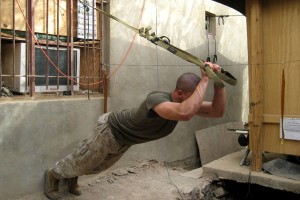2
2013
Suspension training: future of fitness or fad?
Suspension training is a different take on strength training that uses a system of ropes and webbing, called a suspension trainer, to allow the trainee to work against their own body weight.
 The most popular trainer, the TRX was born out of necessity in the Navy SEALs. Randy Hetrick, founder of TRX, spent 14 years serving as a Navy SEAL commando. While there he experimented with an old jiu-jitsu belt and some surplus parachute webbing, hung his handmade contraption and found he could do dozens of exercises with it. Suspension training dates back much further than that, however, and there are now multiple suspension training devices on the market.
The most popular trainer, the TRX was born out of necessity in the Navy SEALs. Randy Hetrick, founder of TRX, spent 14 years serving as a Navy SEAL commando. While there he experimented with an old jiu-jitsu belt and some surplus parachute webbing, hung his handmade contraption and found he could do dozens of exercises with it. Suspension training dates back much further than that, however, and there are now multiple suspension training devices on the market.
Suspension trainers can easily be mounted to support beams, trees, squat racks or doors. Not only are they light but they are extremely easy to travel with and can be used almost anywhere they can be securely and safely attached. The workouts consist of either hanging the legs or leaning back while gripping the straps and then performing different movements. This adds a new twist to push ups, rows, dynamic stretches, and core work.
With each movement, your center of gravity is displaced so that your core musculature is constantly engaged and working hard to assist with stabilization and balance. In almost every exercise, the core is forced to resist gravity and momentum while at the same time use the larger muscle groups to propel the body. This makes exercises on a suspension trainer more metabolically demanding.
The freedom of suspension training allows for movements in all directions, not only front-to-back and side-to-side, but rotational movements as well. We move every day in these three different planes, and rarely use muscles in isolation. These training devices allow you to integrate more muscle groups at once and in a way this represents real life activities and sports.
It is also easy to make any exercise harder or easier through small changes in body position relative to the anchor point, or by changing your base of support. A 70-year-old grandmother can practice squatting holding onto the handles to make the exercise easier with the support of a trainer. Without making any adjustments to the equipment, a 23-year-old football player can get a great strength workout by placing one foot into the trainer squatting with a kettle or dumbbell. This makes it a good tool for both beginners and more advanced athletes of any age.
 While there are numerous benefits there are some drawbacks to suspension training. First off, the devices require some education and practice before using properly. It is also inappropriate for people who haven't built up their core strength. Instead of using their core, these people will use the wrong muscles and connective tissue, increasing the risk of injury and nullifying the benefits. If you are unfamiliar with suspension training you should take a training course or seek the advice of a fitness professional. As always, consult your doctor prior to starting any exercise program.
While there are numerous benefits there are some drawbacks to suspension training. First off, the devices require some education and practice before using properly. It is also inappropriate for people who haven't built up their core strength. Instead of using their core, these people will use the wrong muscles and connective tissue, increasing the risk of injury and nullifying the benefits. If you are unfamiliar with suspension training you should take a training course or seek the advice of a fitness professional. As always, consult your doctor prior to starting any exercise program.
 An article by
An article by 